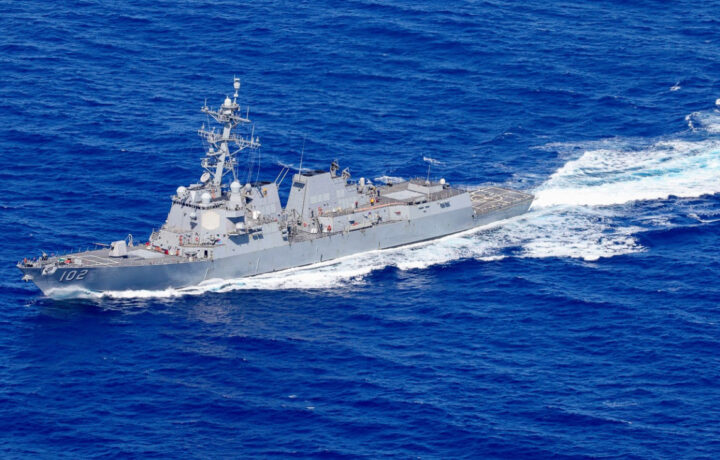The United States Navy has deployed the Arleigh Burke-class guided-missile destroyer USS Sampson (DDG-102) to support operations in the U.S. Northern Command (USNORTHCOM) area of responsibility after the warship departed from Naval Base San Diego on Tuesday.
The guided-missile destroyer is just the latest U.S. Navy vessel to be charged with carrying out operations that support national security priorities. DDG-102 will relieve the Independence-class littoral combat ship USS Charleston (LCS-18), which was only deployed to the region on May 20. It served as a stopgap, replacing another Arleigh Burke-class destroyer, the USS Stockdale (DDG-106), which had been performing the border security mission since mid-April. DDG-106, in turn, relieved USS Spruance (DDG-111), with that guided-missile destroyer beginning the border mission in mid-March.
“Sampson will conduct operations in direct support of USNORTHCOM’s mission to protect the homeland by enhancing maritime domain awareness and deterring illicit activities in coordination with U.S. interagency and law enforcement partners,” the U.S. Navy explained.
This deployment is being carried out as part of the Pentagon’s ongoing efforts to maintain security along the U.S. southern border. During its mission, USS Sampson will operate with an embarked U.S. Coast Guard Law Enforcement Detachment (LEDET), which serves to strengthen the warship’s “ability to conduct maritime interdiction operations, contribute to border security, and support counter-narcotics efforts and humanitarian missions as needed.”
According to the U.S. Navy, warships have been dispatched on both coasts to the border to support anti-trafficking and immigration operations. Last week in the Caribbean Sea, USS Gravely (DDG-107) and LEDET 401 seized $13.5 million in cocaine, USNI News reported. DDG-107 began its mission in March, around the same time DDG-111 was first deployed on the West Coast.
Flight IIA Ageis Guided-Missile Destroyer
USS Sampson is a Flight IIA Aegis guided missile destroyer, named to honor Admiral William Thomas Sampson, who led the U.S. Navy to victory at the Battle of Santiago de Cuba during the Spanish-American War.
The warship was built by Bath Iron Works in Bath, Maine, and commissioned in November 2007. She displaces 9,200 tons and is 155 meters in length.
The crew consists of approximately 380 sailors, and the warship can carry out a variety of missions, including surface warfare, ballistic missile defense, and anti-submarine warfare, while also being capable of precision strikes against land and sea targets. It is armed with an Aegis combat system that supports a wide range of weapons through 96 Mk 41 vertical launch system cells. It can fire IM-66, RIM-156, and RIM-174 surface-to-air missiles, Tomahawk cruise missiles, RUM-139 anti-submarine rockets, and quad-packed ESSM.
Secondary armament includes a 127 mm Mk 45 Mod 4 main gun, a 20 mm Phalanx CIWS, two 25 mm Mk 38 remote weapon stations, several 12.7 mm machine guns, and two triple Mk 32 torpedo launchers for Mk 46, 50, or 54 lightweight torpedoes. It also operates two MH-60R Seahawk helicopters that can carry out anti-submarine warfare, surface search, and tactical reconnaissance.
Eyes in the Sky
In addition to the assets at sea, in February, the U.S. Navy deployed Boeing P-8A Poseidon multi-mission maritime patrol and reconnaissance aircraft to carry out intelligence, surveillance, and reconnaissance (ISR) missions along the southern border with Mexico.
At least one United States Air Force Lockheed U-2 “Dragon Lady” was also deployed to carry out surveillance flights along the U.S.-Mexico border.
The Department of Homeland Security (DHS) also called for an additional 20,000 National Guard troops to help with border and immigration enforcement.




